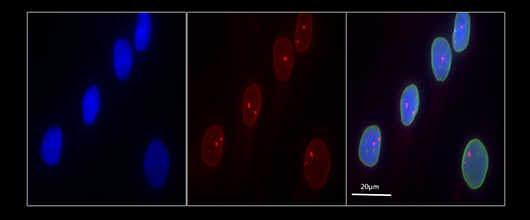Image of the Month: What causes myotonic dystrophy, type1
Myotonic dystrophy, type 1 (DM1) is the second most common cause of muscular dystrophy and numerous other muscle disorders that affect tens of thousands of individuals in the U.S.. This autosomal dominant neuromuscular condition involves multiple tissues including muscle, heart and the central nervous system.
DM1 is caused by a repeat of three letters in the DNA code – CTG – within the 3′ untranslated region of the DMPK gene. When the expanded gene is transcribed, it produces RNA containing long tracts or repeats of CUG (CUGexp), which can be visualized in the nuclear foci of the image below.

The lab of Dr. Thomas Cooper discovered that the CUGexp RNA disrupts the regulation of RNA splicing that is important for proper functions of a large number of genes.
This effect is due to altered functions of CELF1 and MBNL proteins, and the MEF2 transcription factor, which results in RNA mis-splicing and expression of fetal isoforms that cannot fulfill the functional requirements of adult tissues, leading to the neuromuscular disorder.
“We are interested in understanding the mechanisms and consequences of the regulation of the process of alternative splicing of RNA, from how RNA binding proteins and signaling pathways coordinate RNA processing networks to the functional consequences of the different protein isoforms that are expressed in different cell states,” said Cooper.
The Cooper lab’s research has led to a better understanding of the molecular mechanisms of DM1 pathogenesis as well as to the development of several therapeutic approaches some of which are being tested using mouse models established in the lab.

Dr. Thomas Cooper is a professor of pathology & immunology, of molecular and cellular biology and of molecular physiology and biophysics at Baylor College of Medicine.
Visit Tom Cooper lab‘s webpage



